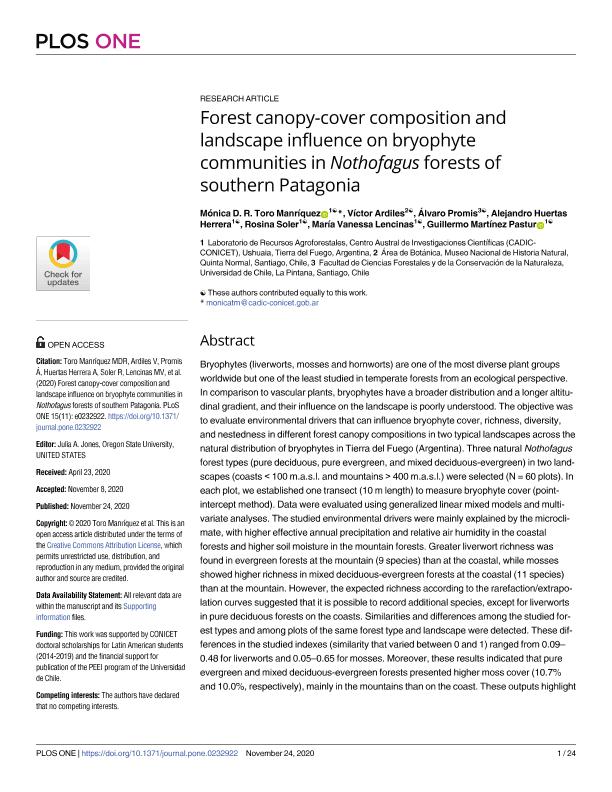Artículo
Forest canopy-cover composition and landscape influence on bryophyte communities in Nothofagus forests of southern Patagonia
Toro Manríquez, Mónica del Rosario ; Ardiles, Víctor; Promis, Álvaro; Huertas Herrera, Alejandro
; Ardiles, Víctor; Promis, Álvaro; Huertas Herrera, Alejandro ; Soler Esteban, Rosina Matilde
; Soler Esteban, Rosina Matilde ; Lencinas, María Vanessa
; Lencinas, María Vanessa ; Martínez Pastur, Guillermo José
; Martínez Pastur, Guillermo José
 ; Ardiles, Víctor; Promis, Álvaro; Huertas Herrera, Alejandro
; Ardiles, Víctor; Promis, Álvaro; Huertas Herrera, Alejandro ; Soler Esteban, Rosina Matilde
; Soler Esteban, Rosina Matilde ; Lencinas, María Vanessa
; Lencinas, María Vanessa ; Martínez Pastur, Guillermo José
; Martínez Pastur, Guillermo José
Fecha de publicación:
11/2020
Editorial:
Public Library of Science
Revista:
Plos One
ISSN:
1932-6203
Idioma:
Inglés
Tipo de recurso:
Artículo publicado
Clasificación temática:
Resumen
Bryophytes (liverworts, mosses and hornworts) are one of the most diverse plant groups worldwide but one of the least studied in temperate forests from an ecological perspective. In comparison to vascular plants, bryophytes have a broader distribution and a longer altitudinal gradient, and their influence on the landscape is poorly understood. The objective was to evaluate environmental drivers that can influence bryophyte cover, richness, diversity, and nestedness in different forest canopy compositions in two typical landscapes across the natural distribution of bryophytes in Tierra del Fuego (Argentina). Three natural Nothofagus forest types (pure deciduous, pure evergreen, and mixed deciduous-evergreen) in two landscapes (coasts < 100 m.a.s.l. and mountains > 400 m.a.s.l.) were selected (N = 60 plots). In each plot, we established one transect (10 m length) to measure bryophyte cover (pointintercept method). Data were evaluated using generalized linear mixed models and multivariate analyses. The studied environmental drivers were mainly explained by the microclimate, with higher effective annual precipitation and relative air humidity in the coastal forests and higher soil moisture in the mountain forests. Greater liverwort richness was found in evergreen forests at the mountain (9 species) than at the coastal, while mosses showed higher richness in mixed deciduous-evergreen forests at the coastal (11 species) than at the mountain. However, the expected richness according to the rarefaction/extrapolation curves suggested that it is possible to record additional species, except for liverworts in pure deciduous forests on the coasts. Similarities and differences among the studied forest types and among plots of the same forest type and landscape were detected. These differences in the studied indexes (similarity that varied between 0 and 1) ranged from 0.09- 0.48 for liverworts and 0.05-0.65 for mosses. Moreover, these results indicated that pure evergreen and mixed deciduous-evergreen forests presented higher moss cover (10.7% and 10.0%, respectively), mainly in the mountains than on the coast. These outputs highlight the need to explore differences at greater altitudinal ranges to achieve sustainability objectives conservation planning for bryophytes in southernmost forests.
Palabras clave:
Drivers
,
Mosses
,
Liverworts
,
Nothofagus
Archivos asociados
Licencia
Identificadores
Colecciones
Articulos(CADIC)
Articulos de CENTRO AUSTRAL DE INVESTIGACIONES CIENTIFICAS
Articulos de CENTRO AUSTRAL DE INVESTIGACIONES CIENTIFICAS
Citación
Toro Manríquez, Mónica del Rosario; Ardiles, Víctor; Promis, Álvaro; Huertas Herrera, Alejandro; Soler Esteban, Rosina Matilde; et al.; Forest canopy-cover composition and landscape influence on bryophyte communities in Nothofagus forests of southern Patagonia; Public Library of Science; Plos One; 15; 11-2020; 1-24
Compartir
Altmétricas



